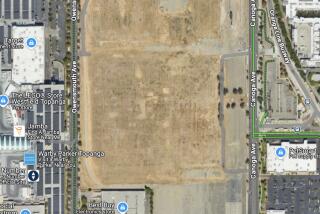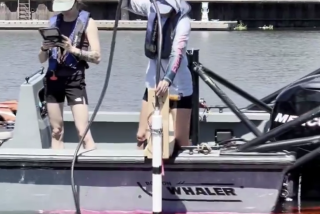Radioactive Pollution Found in Test Well : Rockwell: Tritium seeped into ground water near the Simi Hills lab, but at safe levels, company officials say.
- Share via
Test results announced Friday revealed for the first time that low-level radioactive pollution has seeped into ground water near Rockwell International’s Santa Susana Field Laboratory, contrary to past assurances that nuclear operations at the site east of Simi Valley had no impact on ground water.
Tritium, a form of radioactive hydrogen, was found in a test well 100 feet northwest of Rockwell’s property line, although at levels below drinking water limits, said officials with Rockwell’s Rocketdyne division.
The tritium ranged between 3,780 and 5,410 picocuries per liter of water, well within the drinking-water standard of 20,000 picocuries per liter. Environmental officials said that the tritium poses no risk and that people and livestock in the area don’t rely on ground-water wells.
Nonetheless, representatives of Rockwell and environmental agencies said the levels were too high to have occurred naturally, and almost certainly seeped from the test site--where Rockwell formerly did nuclear work for the U.S. government.
“We don’t have much doubt that they came from our operation,” said Phil Rutherford, manager of radiation protection and health physics for Rockwell’s Rocketdyne division. The levels “are too far above background,” he said.
Rockwell disclosed earlier in August that water samples from the same well contained concentrations of the chemical solvent trichloroethylene ranging from 7 to 19 parts per billion.
Officials said that test results from three other off-site wells are expected this fall.
The well samples were taken on property owned by the Brandeis-Bardin Institute near Simi Valley, which runs a children’s day camp about a mile from the well.
“It doesn’t present a health risk because we’re not drinking the water,” said Helen Eisenstein, an attorney and member of the institute’s board. “It’s in a very remote area from the camp.”
But Eisenstein said that the institute is conducting its own investigation of soil and ground-water contamination.
“We have retained our own consultants,” Eisenstein said. “We feel it is no longer appropriate to sit back and let others reassure us that everything is fine.”
“One of our primary concerns is that for years Rockwell has maintained that there has been no off-site radioactive contamination,” she said.
Rockwell is engaged in a multi-year cleanup of mostly low-level chemical and radioactive contamination from more than 30 years of nuclear research at the test site in the Simi Hills. Under pressure from regulators, the company has beefed up off-site ground-water monitoring for pollutants that may have seeped beyond its property.
Company officials repeatedly stated in the past that there was no evidence of off-site ground-water contamination. On one occasion last year, the company said testing had shown that past nuclear activities had “in no way impacted ground water.”
However Rockwell, which traditionally had tested for some radioactive elements, had not sampled for tritium, contending there was no need to look for the substance.
Gregg Dempsey, a branch chief with the EPA’s office of radiation programs in Las Vegas, had criticized the lack of tritium tests--pointing out that tritium is a good indicator of potential contamination because of its rapid movement through soil. Then Dempsey in 1989 found tritium in ground water near a former nuclear reactor building known as Building 59.
Although of no immediate health concern, Dempsey said the new findings should trigger a search for the building or area from which the tritium had leaked.
Rutherford said he believed the tritium leaked from Building 59, which he said is about 200 to 300 yards from the test well.
Times staff writer Carlos V. Lozano contributed to this story.
More to Read
Sign up for Essential California
The most important California stories and recommendations in your inbox every morning.
You may occasionally receive promotional content from the Los Angeles Times.










